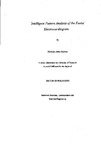Intelligent Pattern Analysis of the Foetal Electrocardiogram
| dc.contributor.author | Outram, Nicholas John | |
| dc.contributor.other | School of Engineering, Computing and Mathematics | en_US |
| dc.date.accessioned | 2013-11-05T13:13:24Z | |
| dc.date.available | 2013-11-05T13:13:24Z | |
| dc.date.issued | 1998 | |
| dc.identifier | NOT AVAILABLE | en_US |
| dc.identifier.uri | http://hdl.handle.net/10026.1/2601 | |
| dc.description.abstract |
The aim of the project on which this thesis is based is to develop reliable techniques for foetal electrocardiogram (ECG) based monitoring, to reduce incidents of unnecessary medical intervention and foetal injury during labour. World-wide electronic foetal monitoring is based almost entirely on the cardiotocogram (CTG), which is a continuous display of the foetal heart rate (FHR) pattern together with the contraction of the womb. Despite the widespread use of the CTG, there is no significant improvement in foetal outcome. In the UK alone it is estimated that birth related negligence claims cost the health authorities over £400M per-annum. An expert system, known as INFANT, has recently been developed to assist CTG interpretation. However, the CTG alone does not always provide all the information required to improve the outcome of labour. The widespread use of ECG analysis has been hindered by the difficulties with poor signal quality and the difficulties in applying the specialised knowledge required for interpreting ECG patterns, in association with other events in labour, in an objective way. A fundamental investigation and development of optimal signal enhancement techniques that maximise the available information in the ECG signal, along with different techniques for detecting individual waveforms from poor quality signals, has been carried out. To automate the visual interpretation of the ECG waveform, novel techniques have been developed that allow reliable extraction of key features and hence allow a detailed ECG waveform analysis. Fuzzy logic is used to automatically classify the ECG waveform shape using these features by using knowledge that was elicited from expert sources and derived from example data. This allows the subtle changes in the ECG waveform to be automatically detected in relation to other events in labour, and thus improve the clinicians position for making an accurate diagnosis. To ensure the interpretation is based on reliable information and takes place in the proper context, a new and sensitive index for assessing the quality of the ECG has been developed. New techniques to capture, for the first time in machine form, the clinical expertise / guidelines for electronic foetal monitoring have been developed based on fuzzy logic and finite state machines, The software model provides a flexible framework to further develop and optimise rules for ECG pattern analysis. The signal enhancement, QRS detection and pattern recognition of important ECG waveform shapes have had extensive testing and results are presented. Results show that no significant loss of information is incurred as a result of the signal enhancement and feature extraction techniques. | en_US |
| dc.language.iso | en | en_US |
| dc.publisher | University of Plymouth | en_US |
| dc.title | Intelligent Pattern Analysis of the Foetal Electrocardiogram | en_US |
| dc.type | Thesis | |
| plymouth.version | Full version: final and full version as approved by the examiners at the time of the award of your degree | en_US |
| dc.identifier.doi | http://dx.doi.org/10.24382/4844 | |
| dc.identifier.doi | http://dx.doi.org/10.24382/4844 |
Files in this item
This item appears in the following Collection(s)
-
01 Research Theses Main Collection
Research Theses Main


